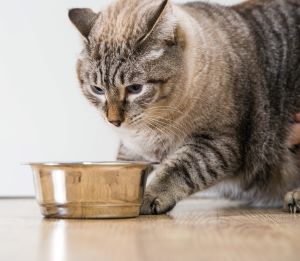Cat eating from metal bowl

There always seems to be the occasional cat for which the traditional therapies do not seem to be appropriate.
- Radiotherapy is not an insignificant expense and may be financially out of reach.
- Some cats simply will not take oral medications.
- The compounded ear ointments do not always work.
- Some owners are simply unable to give medications twice daily indefinitely with meaningful regularity.
- Some cats have a concurrent illness that precludes methimazole or simply does not tolerate its side effects.
Iodine is an essential ingredient your cat needs to make thyroid hormone; therefore, it should not be surprising that the production of excessive amounts of thyroid hormone requires excessive amounts of iodine (in the case of hyperthyroidism). Since iodine comes from the diet, it turns out that it is possible to create a diet that is restricted enough in iodine to preclude the production of excessive amounts of the hormone yet not so restricted that an iodine deficiency results. Hill’s Pet Nutrition has developed such a diet, called y/d, and it has been an alternative to the more traditional therapies since 2011. The diet is available in both dry and canned formulations in some regions. Always consult with your veterinarian before changing your pet’s therapeutic diet.
How Long do you Have to Feed the Diet for the Cat Not to be Hyperthyroid Anymore?
Several studies have been done, and hundreds of cats have been evaluated. Many cats will have normal thyroid levels in the first two months of diet use; however, a full response can take up to 12 weeks. By 12 weeks on the diet, 90% will show normal thyroid levels. The diet is ineffective in approximately 10% of cats eating it.
Can a Cat Have any Treats While on this Diet?
Unfortunately, there are no acceptable treats. Feeding ANY thing other than the therapeutic diet could interfere with the effectiveness of treatment. Foods or treats meant for other pets in the home should be kept away from a cat on this form of therapy. Also, hyperthyroid cats who roam outside may be eating any number of things out in the world. It is unlikely that their diet can be controlled enough for this form of therapy to be effective. In fact, if the cat on y/d is still hyperthyroid after eight weeks, it can be assumed that the cat is finding another iodine source. The cat might simply be cheating on the diet, getting extra iodine in medication or in drinking water, or even from the surface of a food bowl.
Can Other Cats in the Household Eat this Diet Safely?
After over a decade of Y/d diet availability, it appears that normal cats may safely eat Y/d diet. No reactions or problems were found when the diet was experimentally fed exclusively to normal cats for a two-year period. Further, no issues have come up in the pet-owning population. If multiple cats are present in the home and feeding separately is problematic, it should be fine to feed all the cats the iodine-restricted diet.
The manufacturer suggests taking a week to transition the cat from his normal food to this one, not because of the iodine issue but because it is always a good idea to avoid an abrupt food change. After the transition is complete, Hills recommends a thyroid level, kidney parameters, a recheck exam, and a urine specific gravity (test for urine concentration) after four weeks and again after eight weeks on a Y/d diet. If your cat is still not showing a normal thyroid level in eight weeks, it is worth going out to 12 weeks and evaluating one more time. After your cat has achieved a normal thyroid level, an exam, and blood work should be performed every six months.
In cats with concurrent kidney disease, lab work is recommended after two, four, and eight weeks on the diet and every three to four months thereafter.
What about Switching a Cat on Methimazole Over to the Diet?
The manufacturer recommends simply switching from medication to diet directly with no transitional period. Simply discontinue the medication and start the diet.
Methimazole, surgery, and radiotherapy are well-reviewed effective therapies for feline hyperthyroidism. Where this diet fits in the picture and whether it should replace traditional therapy or be considered an acceptable last resort remains to be seen over time.